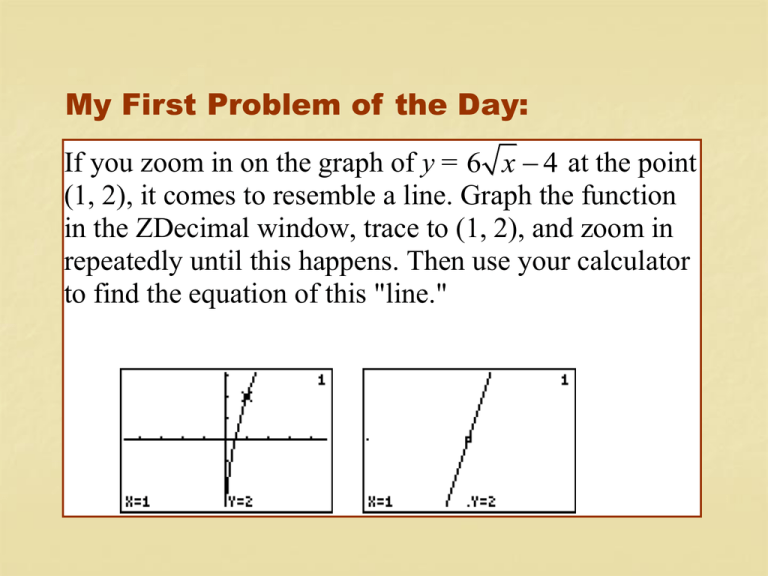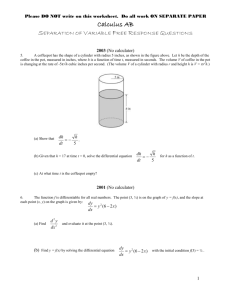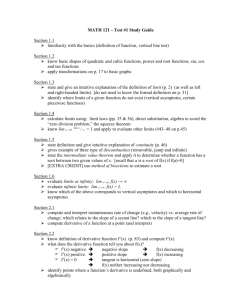Local Linearity (Powerpoint)
advertisement

My First Problem of the Day: If you zoom in on the graph of y = 6 x 4 at the point (1, 2), it comes to resemble a line. Graph the function in the ZDecimal window, trace to (1, 2), and zoom in repeatedly until this happens. Then use your calculator to find the equation of this "line." Point-Slope Equation of a Line: y y1 m( x x1 ) Linearization of f at x = a: y f (a) f (a)( x a) or y f (a) f (a)( x a) This simple equation is the basis for: Instantaneous rate of change Differentials Linear approximations Newton’s Method for Finding Roots Rules for Differentiation Slope Fields Euler’s Method L’Hopital’s Rule What is Instantaneous Rate of Change? If a rock falls 20 feet in 2 seconds, its average velocity during that time period is easily measured: 20 feet 10 ft/sec 2 sec But what if we capture that rock at a moment in time and ask for its instantaneous velocity at that single moment? What is the logical reply? 0 feet 0 ft/sec 0 sec 0 Obviously, traditional algebra fails us when it comes to instantaneous rate of change. feet seconds But if we graph the rock’s position as a function of time, we see that velocity is the same as slope. Instantaneous velocity is just the slope of the zoomed-in picture – which is linear! That’s what differentials are all about. Since the derivative is the slope of the curve at a point, there is no true Δy or Δx…but there is a slope. So we write: y dy lim x 0 x dx If we zoom in on a differentiable curve, because it is locally linear, Δy/ Δx is essentially constant. That makes dy/dx defensible as something other than 0/0. If we zoom in at a point (a, f(a)): y lim f (a) x 0 x So… if (x, y) is close to (a, f(a)), y f (a) f (a) y f (a) f (a)( x a) xa There’s that equation again! This is the basis for linear approximations. For example, here is Problem of the Day #23: Find the linearization of f ( x ) x at x = 100 and use it to approximate 101 . Use f to predict whether the approximation will be slightly smaller or slightly larger than the actual value. 1 y 100 x 100 2 100 1 y 10 101 100 y 10.05 20 The Good News: Modern students can check how close this approximation is by using a calculator. The Bad News: Modern students do not appreciate how much these approximation tricks meant to their ancestors. Another such method is Newton’s Method for approximating roots. Here is Problem of the Day #22: The line shown is tangent to the graph of y = f(x) at the point (a, f(a)). (a, f(a)) (a) Find an equation of the line. (b) Find the x-intercept of this line in terms of a. y f (a ) f (a )( x a ) 0 f (a ) f (a )( x a ) f (a) xa f (a ) Then we name this x-intercept b. Using (b, f(b)) as the new point, I have them repeat the process. Clever students quickly write: f (b) xb f (b) (a, f(a)) Eventually this process will zoom in on an x-intercept of the curve. This is Newton’s Method for approximating roots of equations. For example, let us find a root of the equation sin x = 0. Start with a guess of a = 2. sin a xa a tan a cos a 2 Local linearity even led to the discovery of the differentiation rules. For example, here’s the product rule. Zoom in on a product function uv until it looks linear. The slope will be the derivative of uv. (x + dx, (u + du)(v + dv)) d(uv) (x, uv) dx d (uv) (u du )(v dv ) uv dx dx uv udv vdu dudv uv dx udv vdu dudv dx dv du dv u v du dx dx dx A slope field is all about local linearity. dy x y dx At each point (x, y) the differential equation determines a slope. This is the very essence of point-slope! Here is Problem of the Day #37: Suppose y = f(x) satisfies the differential equation dy x y . Find the linearization of f at the point (1, 1) dx and use it to approximate f(1.1). Then use the linearization at the new point to approximate f(1.2). This is Euler’s Method. The picture at the right shows how it works. dy dx ( x x , y y ) (x, y) dy y x dx Slope x You start with a point on the curve. Find the slope, dy/dx. Now move horizontally by Δx. Move vertically by Δy = (dy/dx) Δx. This gives you a new point (x + Δx, y + Δy). Repeat the process. I like to use a table. (x, y) dy/dx Δx Δy (x + Δx, y + Δy) (1, 1) 2 0.1 0.2 (1.1, 1.2) 2.2) (1.1, 1.2) 2.2) 2.3 0.1 0.23 (1.2, 1.43) Since 2000, the AP Calculus Test Development Committee has been purposefully re-directing the philosophy of the AP courses away from mere computation and toward a better understanding of calculus concepts. A big component of this new philosophy has been the emphasis on multiple representations: Graphical Analytic Numerical (Tabular) Verbal In differential calculus, this new emphasis has led to the emergence of some new kinds of AP problems: Linking f , f , f graphically Derivatives from Tables Differential Equations Interpreting the Derivative Slope Fields Euler’s Method (BC) Logistic Growth (BC) Problem of the Day #16: The graph shown below is the graph of y f ( x) . Note that the questions refer to the function f, which is not given. (a) (b) (c) (d) (e) On what intervals is f increasing? JYA. On what intervals is the graph of f concave downward? JYA. At what x-value does f have a relative maximum? JYA. Identify the x-coordinates of the inflection points of the graph of f. JYA. Sketch a possible graph of y = f(x). 2003 / AB-4 BC-4 y 2 (–3, 1) –4 –2 2 4 x –2 (4, –2) Let f be a function defined on the closed interval 3 x 4 with f(0) = 3. The graph of f , the derivative of f, consists of one line segment and a semicircle, as shown above. (a) On what intervals, if any, is f increasing? Justify your answer (b) Find the x-coordinate of each point of inflection of the graph of f on the open interval 3 x 4 . Justify your answer. (c) Find an equation of the line tangent to the graph of f at the point (0, 3). Most tabular problems have derivative and integral parts. This is 2001 / AB-2 BC-2. The temperature, in degrees Celsius (C), of the water in a pond is a differentiable function W of time t. The table to the right shows the water temperatures as recorded every 3 days over a 15-day period. (a) Use data from the table to find an approximation for W (12) . Show the computations that lead to your answer. Indicate units of measure. t (days) W(t) ( C) 0 3 6 9 12 15 20 31 28 24 22 21 (c) A student proposes the function P, given by P(t ) 20 10te( t / 3) , as a model for the temperature of the water in the pond at time t, where t is measured in days and P(t) is measured in degrees Celsius. Find P(12) . Using appropriate units, explain the meaning of your answer in terms of water temperature. Differential Equations have changed emphases many times in the history of AP Calculus. At this time AB and BC students are responsible for solving two types: dy 2 sec x Exact, for example dx dy x Separable, for example dx y A differential equation becomes an initial value problem when the solver knows a point on the solution curve, thus determining the value of the constant of antidifferentiation . This also implies a domain for the solution. Thus: dy 2 sec x and y 1 when x 0. dx y tan x C y tan x 1 for 2 x 2 only. Notice that the point (0, 1) pins down the correct curve, but only on the interval containing that continuous piece of the graph. To satisfy the differential equation and the initial condition, the graph could just as well look like this: 2006 / AB-5 combined slope fields with a differential equation…and a surprise. dy 1 y Consider the differential equation , where x ≠ 0 dx x (a) On the axes provided, sketch a slope field for the given differential equation at the eight points indicated. 1 -2 -1 0 1 2 -1 (b) Find the particular solution y = f(x) to the differential equation with the initial condition f (1) 1 and state its domain. 2005 / BC-4 (with Euler’s Method) dy 2x y . dx On the axes provided, sketch a slope 2 field for the given differential equation 1 at the twelve points indicated, and sketch the solution curve that passes 0 -1 1 2 through the point (0, 1) The solution curve that passes through the point (0, 1) has a local minimum at x = ln(3/2). What is the y-coordinate of this minimum? Let y = f (x) be the particular solution to the given equation with the initial condition f(0) = 1. Use Euler's method, starting at x = 0 with two steps of equal size, to approximate f(–0.4). Show the work that leads to your answer. d2y Find 2 in terms of x and y. Determine whether the dx approximation found in part (c) is less than or greater than f(–0.4). Explain your reasoning. Consider the differential equation (a) (b) (c) (d) 2004 / BC-5 (Logistic Growth) A population is modeled by a function P that satisfies the logistic differential equation dP P P 1 . dt 5 12 (a) If P(0) = 3, what is lim P (t ) ? t If P(0) = 20, what is lim P (t ) ? t (b) If P(0) = 3, for what value of P is the population growing the fastest? (c) A different population is modeled by a function Y that satisfies the separable differential equation dY Y t 1 . dt 5 12 Find Y(t) if Y(0) = 3. (d) For the function Y found in part (c), what is lim Y (t ) ? t If students had been asked to solve the logistic differential equation, it would have required partial fractions. In fact, it can be done in the general case: dP kP ( M P ) dt M P ( Mk ) t 1 Ae In the case of 2004 / BC-5: dP P P 1 dt 5 12 dP 1 P 12 P dt 60 12 P (1/ 5) t 1 Ae 12 P if P (0) 3. 0.2 t 1 3e Problem of the Day #53: The graphs of two differentiable functions f and g cross the x-axis at x = a, as shown: a When we zoom in at (a, 0), the graphs will resemble their f ( x) linearizations. Find a formula for lim by replacing f(x) and g(x) x a g ( x ) by their linearizations and simplifying. dkennedy@baylor.chattanooga.net





